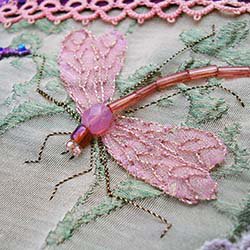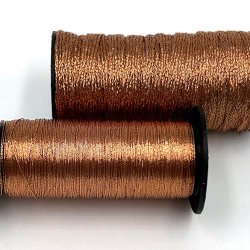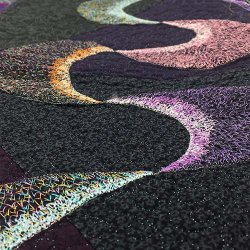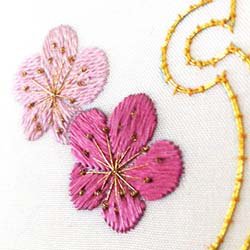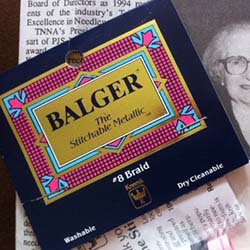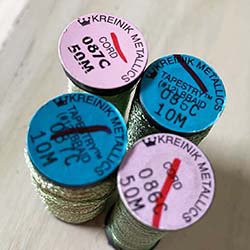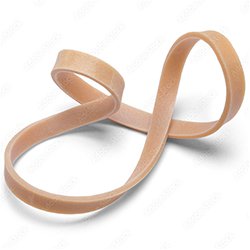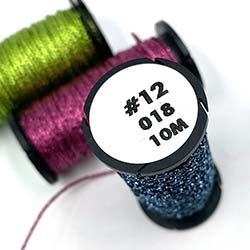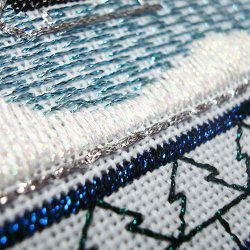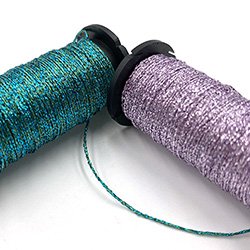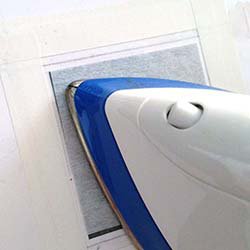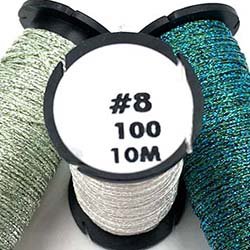- Shop Fly Fishing
-
Shop Needlework
- Metallic Threads
- Silk Threads
- Kits & Sets
- Accessories
- Free Patterns
- How To
17 products found
Sort by:
Recommended
Shop Needlework > How To > Metallic Thread
-
How to use metallics in crazy quilting
By Pat Winter, crazy quilt artist, designer and writer
I am a crazy quilter and I prefer Kreinik Metallic thread for my hand stitched seam treatments. Not only does Kreinik come in a variety of thicknesses, but the color assortment is amazing and fits all my designing needs. The ”vintage” colors are superb and among my favorite because I love to work in Victorian colors.
I first used Kreinik threads over 20 years ago when I combined it with my cotton floss in my cross stitch projects. The sparkle really made the piece come alive. I now use Kreinik metallic threads for my embroidery stitches in my crazy quilt items. Metallic threads make simple stitches stand out.
Is there a difference in thread?
I have tried various metallic threads as I would find them while browsing a quilt booth or new shop thinking they are all the same. I was surprised to find most of them frustrating to work with. They would break with very little pressure, and fray. I always use a sharp needle with a large eye when I hand sew with metallic threads so I was not adding stress by pulling thread through a tight fabric. I use every fabric imaginable in my crazy quilting and I can always depend on Kreinik threads to do the job with ease and no breakage.
Which thread for which design?
In most of my seams I prefer to use Very Fine # 4 braid and Fine #8 braid because it allows me to create small close stitches which I can add several combination stitches with by adding more colors to coordinate with the fabrics I used in the project. This makes a much more interesting seam in Fig. A.
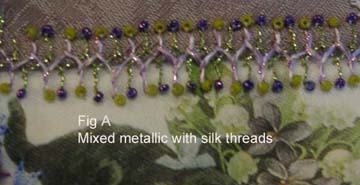
I use Blending Filament to outline a printed image or add it to a silk thread for a sparkle in fig. B.
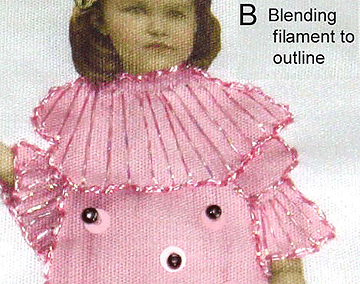
Cord is great for spider webs and legs of a beaded spider or insect. I also use it for the feather stitch down each dragonfly wing for great detail in fig. C.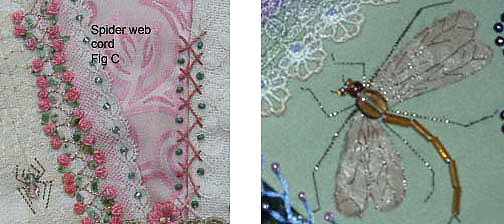
Larger seams call for larger threads. For these I use 1/16" Ribbon or Medium #16 Braid in fig. D.
Helpful hints when using metallic threads for hand stitching:
1. Always use a sharp needle with a large eye for smooth sewing and no tugging through fabrics.
2. Unwind a length of 18 inches and pull it through your fingers to unwind before you begin to sew. This relaxes it and it won't wind up on you.
3. I have never had Kreinik metallic thread tangle on me, but if you find this happening, run it through Thread Heaven, a light silicon lubricant or bees wax. -
What is a Corded Braid?
If a Kreinik Braid or Ribbon color has the letter C in it—such as 002C, or 005C—that means it's a "corded Braid" or "braided Cord." This is a special kind of fiber that requires a little extra stitching care. Let's start with the core fiber...
Kreinik Cord is a single-strand thread that has a metallic covering tightly wrapped over a core (gimp). Imagine a very thin, wire-like metallic thread that is strong enough to be used in a sewing machine but thin enough to add a clean line to designs.
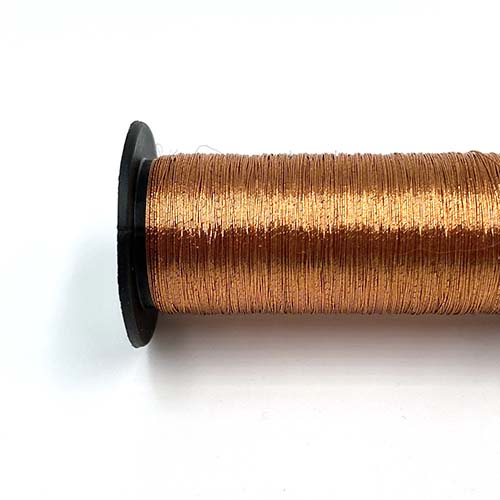
This Kreinik Cord is used to make Kreinik corded braids and corded ribbons. These heavier threads carry a "C" after the color number and have a nubby, real-metal appearance. Corded Braids are increasingly being used in place of real metal threads because they closely resemble them and are less costly.
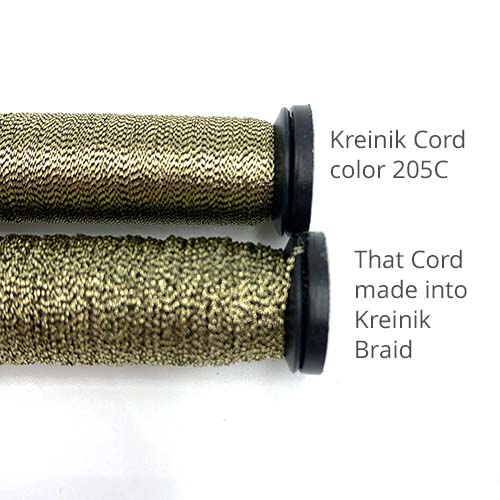
Besides being an alternative to real-metal threads, corded braids are also used in a design when you want to add a nubby texture — such as the wheel on a locomotive. While basic metallic braids give a shiny finish, the nature of a corded braid makes it more subdued and texturized, thus opening up a world of design possibilities. Imagine using Kreinik Medium #16 Braid 002C Gold alongside Cord 002C Gold, for example; you will get two different textures from the same color.
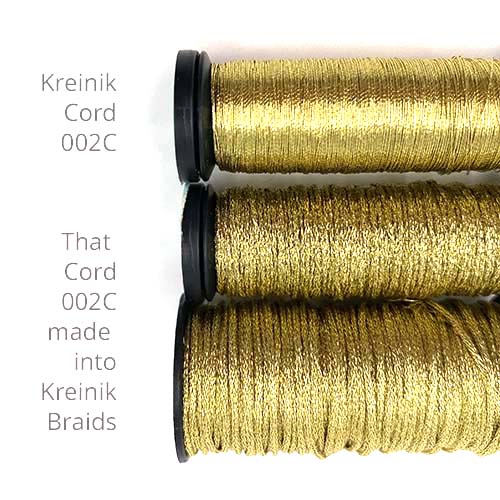
Since the core fiber is a strong, wire-like thread, a corded braid can be slightly thicker or stiffer than a basic braid. So most corded braids are couched onto the surface of a design using a matching color of Kreinik Cord as the tacking thread. If you stitch in and out of a fabric with a corded braid (rather than couch it), then simply stitch carefully, slowly, and with a larger needle to open the hole in the canvas sufficiently.
Enjoy the corded braids when you are adding different textures to make your design look more realistic or exciting. They come in different braid sizes: Tapestry #12 Corded Braid colors are about .60mm thick, while Medium #16 Corded Braid colors are slightly thicker at .81mm thick. Choose the size that suits your chosen stitch and pattern.
-
How to use Kreinik Cord
Applications
Appliqué (machine), blackwork, costumes, crazy quilting (hand and machine), crewel, cross stitch, doll making (by hand and machine), machine embroidery/bobbin work, machine embroidery/in the needle, miniatures, needlepoint/canvas work, punch embroidery, quilting (hand and machine), ribbon embroidery (hand and machine), smocking, stumpwork.
Hand Embroidery- Cord has a rich metallic color that brings definition to designs. This single-strand thread is ideal for outlining on fabric. When backstitched around a motif, for example, the thin, clean line 'lifts' the element off the fabric and thus creates a sense of dimension. It is also excellent for blackwork-style stitchery, 'lacy' effects, and openwork on fabric. You can also use a single strand of Cord to overstitch areas on fabric or canvas, bringing exacting definition or light-play to designs. The thin and strong qualities of Cord also make it ideal for couching thicker Kreinik Braids and Ribbons.
- Match colors of Cord to the thread you are couching to remain invisible, or use a different color to create interesting contrasts. If you enjoy creating the look of gold work, use gold (or silver) colors of Cord to couch real metal threads or corded braids and ribbons.
- Use the blending filament threading technique to thread Cord onto your needle (knot it to your needle to keep it from slipping out as you stitch)
- Use short lengths of thread-about 45cm (18 inches) or less-for greater control (less knotting!) and to avoid excessive abrasion on the thread from repeated passes through the ground fabric or canvas.
- Let your needle hang frequently to let the thread untwist if you have recurring problems with tangling and knotting.
Machine Embroidery
Cord is a strong thread ideal for professional quilting machines or personal sewing machines, whether used in the needle, in the bobbin, or for couching a heavier thread type.
Tips on using Kreinik Cord in a sewing machine:- When using Cord in the needle of a sewing machine for fine stitching or couching a heavier thread, use a Metalfil needle, and experiment with thread set-ups and tension settings. You may need to loosen the top tension; practice until you get a combination that works with your machine, stitches, and fabric choice. Use an off-machine or vertical spool set-up. Also, Sewers Aid lubricant may help if you're having difficulty.
- When using Cord in the bobbin, you may need to loosen the bobbin tension from normal; experiment until you get a set-up that works with your machine and your fabric.
Care
Kreinik Cord is hand or machine washable and dry cleanable. Cool water is recommended. Do not use bleach. It can also be tumble-dried on low setting. When ironing a finished piece containing Kreinik Cord, do not iron directly on the thread; use a cloth, and do not use steam.
-
The History Of Japan Threads
Historically, Japan thread embroidery began in China with gold, silver, and copper metalwork. Gold and silver yarns were made by pounding gold and silver stock into extremely thin leaf, which was sliced into very narrow strips and then rolled around a core and twisted into yarn. With time, the gold yarn was modified to a gilt yarn, which was silver with a gold overlay.
The Japanese later developed a method of making metal threads by depositing a coating of gold or silver on rice paper, which was then cut into fine strips and wrapped around a thread core. This became known as Japan Gold or Japan Silver. However, dampness caused the rice-paper backing to deteriorate. Modern technology has eased the process of making Japan threads, and Kreinik now offers Japan Threads in a variety of thread sizes for hand and machine embroidery.
Kreinik Japan Threads are synthetic, non-tarnishing gimps available in gold, dark gold, silver and copper that give the appearance of stitching with real gold, silver or copper. Since real metal threads are rare and expensive, Japan Threads are an ideal substitute. Japan Threads are available in Super Fine #1, Fine #5, and Medium #7 sizes, also Very Fine, Fine, Tapestry, and Medium Braids plus 1/16" and 1/8" Ribbons and 3/8" Trim.
Japan threads in the Kreinik line are indicated by a "J" following the color number, as in 002J.
-
What to do if you need Balger
"I need the Balger, which thread is it?"
Balger was the name we used for our metallic thread line back in the 1970s/1980s. Today we have about 20 different threads in that line, but back then the number was much smaller. If your design uses that old term "Balger," we know it's probably Blending Filament, Cord, or #8 Braid. In order to figure out which of these three threads your project may be calling for, we need to look at how the thread is being used in the design.
If you have an older project — particularly a cross stitch project — check your chart or pattern for these potentially identifying factors:
- Is the Balger color meant to be combined with cotton floss? If so, it is probably Blending Filament.
- Is the Balger color meant to be used by itself, for a bolder look? It is probably Fine #8 Braid.
- Does the Balger color have a "C" in the color number? It is our thin Cord.
Keep in mind that some colors have been discontinued over the years, and dye lots of changed. -
Discontinued Kreinik metallic colors
We hate to discontinue any thread color, but sometimes it is required due to manufacturing problems (for example, if we can't get the raw material to transform it into your favorite Kreinik threads). You will find the list of discontinued colors below. If you have these in your stash, we recommend putting a mark on the label to indicate a discontinued color.
Important tips for stitchers who buy thread stashes on Ebay, at estate sales, and Goodwill/Salvation Army stores:
- The thread dye lot most likely has changed. Mark those threads so you know and won't get caught running out mid project.
- Some of those threads may be discontinued. Google search or contact the manufacturer to double check before you use them in a project (and end up needing more).
Discontinued Kreinik colors and substitution suggestions:
NM means no close match
- 003C Red Cord = 003 Red
- 005C Black Cord = 005 Black
- 007C Pink Cord = 007 Pink
- 008C Green Cord = 008 Green
- 011C Nickel Cord = 010HL Steel Grey
- 012C Purple Cord = 012 Purple
- 022L = 052HL Bronze
- 026L = 026 Amethyst
- 027L = 027 Orange
- 029L = 029 Turquoise
- 031L Berry Red = 153V Vintage Burgundy
- 032C Pearl Cord = 032 Pearl
- 034 Confetti = NM
- 041 Confetti Pink = 044 Confetti Blue
- 041C Confetti Pink Cord = 044 Confetti Blue
- 042 Confetti Fuchsia = NM
- 042L Optic Opal = NM
- 043 Confetti Green = NM
- 051C Sapphire Cord = 051HL Sapphire Hi Lustre
- 056F Blueberry = NM
- 057F Grape = NM
- 070 Mardi Gras = 5011 Elfin Green
- 080 Garnet in Miro Ice Chenille = Red is a bolder version
- 080C Garnet Cord = 080HL Garnet Hi Lustre
- 086C Fern = 4201 Sugar Cane
- 087C Meadow Grass = 089 Aspen
- 088C Lily Pond Cord = 4201 Sugar Cane
- 195 Sunburst = 095 Starburst
- 2094HL Heather Hi Lustre = NM
- 235 Red Ember = 307 Deep Coral
- 271 Plum = 3223 Ametrine
- 3240 Opal = 095 Starburst
- 3508 Rhumba Green = 829 Mint Julep
- 3509 Cha Cha Verde = 008HL Green Hi Lustre
- 3540 Bolero Black = 005 Black
- 393 Silver Night = 622 Wedgewood Blue
- 4001 Green Tea = 4201 Sugar Cane
- 4002 Spiced Chai = 4202 Dusky Meadow
- 4003 Ginseng Gold = 4203 Cattail
- 4004 Earl Grey = 4204 Storm Cloud
- 4005 Sugar Cube = 102 Vatican Gold
- 4006 Rosehip
- 4639 Light Aqua = 3214 Blue Zircon
- 5002 Pixiedust
- 5004 Love Potion = 024L Fiery Fuchsia
- 5007 Brocade = 5006 Ore
- 5008 Leprechaun = 009 Emerald
- 5525 Lemon = 5725 Lollipop Lemon
- 5530 Rosemary Green = 4201 Sugar Cane
- 664 Magenta Blue = NM
- 9132 Lemongrass = 5725 Lollipop Lemon
- 9300 Orchid = NM (closest pastel is slightly darker 093 Star Mauve)
- Easter Grass in 1/8" Ribbon size (Easter Grass still available in 1/16" and 1/32")
- Marine Blue in Micro Ice Chenille = NM
- Petite/Facets 012 = Petite/Facets 026
- Petite/Facets 029L = NM
-
Never use rubber bands to store thread
This is a public service announcement to needleworkers everywhere. Share with your stitching friends. Help us spread the word that rubber bands are not good when it comes to textiles!
Keep rubber bands away from your threads. Never, ever, ever ever ever wrap them around threads that have a silver content, such as Kreinik Japan Threads, or the "J" colors of Kreinik Braids and Ribbons (001J, 002J, etc). It may sound strange to some, but we have seen this over the years: people secure their threads on a spool by wrapping them with rubber bands. Not good. The sulphur or sulphur compounds in rubber bands will cause your thread to tarnish.
Fortunately, Kreinik's black spools were designed to have their own thread-end holder: tuck the thread into the notches at either end of the spool.

You can even wrap the thread from one notch to another for added security.
-
12 Facts about Tapestry #12 Braid
This little power-house of a fiber is one of the most popular Kreinik Braid sizes for needlepoint, giving perfect coverage in tent stitch on 18-mesh canvas. Beyond needlepoint, it is used in bead knitting, bead crochet, embroidery, and weaving, among other fiber art techniques—even fly fishing. Here are 12 facts about Tapestry #12 Braid that will impress your friends and influence people (or at the very least, improve your stitching and fiber knowledge).
The basics
1. It was created specifically for ideal coverage on 18-mesh needlepoint canvas. At the time, the trend in needlepoint was full coverage, and Fine #8 Braid was too thin for that. With Medium #16 Braid feeling too thick for 18-count, designers asked the Kreinik family to create an in-between size. Tapestry #12 Braid was born (and named Tapestry, aka needlepoint).
2. It comes in more than 200 colors. Your favorite colors in Fine #8 Braid or Medium #16 Braid are also available in #12 Braid. The range is unparalleled in needlework threads, with solid, variegated, antiqued, holographic, and glow-in-the-dark options. Want a home reference? These colors are shown in the Kreinik Metallic Color Card or Kreinik Metallic Thread Color Chart (free download here).
3. It can be varying thicknesses. This is a tricky aspect, but good to know: some colors such as the Cords, Hi Lustre, Holographic, Vintage and Glow In The Dark can be a wee bit heavier than the basic metallic colors. If they appear to be too thick to you when using these special-effect threads, just go down a thread size (to #8 Braid).
4. It comes on 10-meter spools or cones of any size. Doing a large project and want to make sure you have the same dye lot? Simply special order a cone from your favorite needlework store. We can cone any amount.
5. If you use a holographic color, the end is going to fray. It’s the nature of the beautiful beast. That is, holographics are unsupported fibers, so the ends tend to go loosey-goosey when braided. Simply use a clear nail polish or dab of glue on the ends to bind them together before stitching, sewing, weaving, etc.
6. It is available in an overdyed version. The fabulous company ThreadWorx makes the dreamiest variegated shades of Kreinik Tapestry #12 Braid.
7. It’s made in West Virginia. Yes, we make it in the Kreinik factory in Parkersburg, West Virginia. In fact, we’re making some right now.
The possibilities
8. It’s a cross-stitch thread when used on 11-count Aida. Use one strand, straight from the reel, on larger fabrics like 11-count Aida, or unusual fabrics like screens. You can get your favorite colors of Very Fine #4 Braid in this size too.
9. It’s the perfect weight for bead knitting. Translucent beads are even more beautiful with the metallic braid running through them. Search “Metallic Tapestry #12 Braid” on Revelry to see gorgeous bead knitting creations. Many of Earth Faire’s Bead Soup and Bead Stew projects feature #12 Braid.
10. You can crochet with it. Considered a super fine weight, it makes beautiful crocheted Christmas ornament designs. Use it alone for jewelry, appliqués, and other accessories., or add beads for bead crochet projects.
11. It’s a favorite among adventurous tatting enthusiasts. Imagine the snowflake ornaments you can make tatting with color 032 Pearl. We’ve seen dragons, insects, and Christmas motifs made with the light metallic (choose a basic color, not Hi Lustre, Vintage, or Cord color).
-
How to Use Kreinik Ombre
It's time to learn about this unique thread: Kreinik Ombre™. You can use it in needlepoint, samplers, weaving, knitting, crochet, embroidery, cord making, Temari and bobbin work, among other techniques. It's a loosely twisted metallic designed to give a loosely woven effect in needlework. The core color range is variegated, going along with the origin of the word, which gives you interesting color effects.
The word "ombre" in general refers to the gradual blending of one color hue to another. The color effect is popular in hair styles right now, as well as fashion (skirts, shirts, handbags), home decor (pillows, window treatments), and even nail polish.
In needlework, the Kreinik thread Ombre is best used in specialty stitches such as Satin Stitch, Herringbone, and others that show off the loose twist and the variegated color. It was one of the first non-Braid threads Kreinik made back in the company's early days, and was particularly popular when machine knitting was in vogue. Since the unique texture of Ombre became so useful to stitchers for creating various effects, the Kreinik family started making it solid colors as well as variegated.
Ombre offers you a unique thread with elegance and texture. Get at least one solid color (we love 3200 Pearl for snow and 2000 Gold or 1000 Silver for Christmas) and one variegated color (1600 Misty Lavender is popular) to start experimenting in your projects. Read on to learn more.
What is Kreinik Ombre?- An 8-ply softly twisted metallic thread
- In nine variegated colors
- Also in four solid colors (Gold, Silver, Pearl, Copper)
- Comes on 15-meter spools or larger cones
- Most often used in needlepoint, bobbin work, counted thread (samplers), card making, knitting, weaving, embroidery, Temari, cord making
- For an interesting look in cross stitch, use Ombre for French Knots — they'll be fluffier
- It is meant to be used straight off the spool, as it comes, not separated
Why would you want a loose twist?
- It creates a stitch that "lifts" off the surface of your canvas/fabric, creating added loft, texture, and dimension.
- In knitting and crochet, it gives you a metallic look but in a super-soft thread. It is one of the softest metallics you'll ever feel.
- In needlepoint and counted thread, it gives you a unique, fluffy texture—imagine snow drifts, jacquard fabrics, and other "risen" effects.
Why would you want a metallic?
- Adds elegance
- Makes a design look more expensive
- Adds light reflection
- Adds a different texture
- For visual interest
How to use Ombre:
- In hand stitchery, use it straight off the reel, with a #22 Tapestry needle or a #18 Chenille needle; longer or decorative stitches are best for showing off the fuzzy texture or variegated color.
- In crochet and knitting, use it as a carry along to dress up alpaca, cotton, wool, silk or any yarn.
- In bobbin work, use a coordinated color of #60 or #80 cotton, mono, or rayon thread in the top; makes lovely raised, nubby effects in particular with zig zag and decorative stitches—lengthen stitch length slightly. Lovely in digitized embroidery designs or programmed machine stitches (looks like you have stitched with glitter).
-
How to use Fine #8 Braid
Fine #8 Braid is possibly the most versatile metallic thread since it can be used by just about every creative technique. It is the perfect size for needlepoint, cross stitch, embroidery, crazy quilting, weaving, bead knitting, bead crochet, tatting, fly fishing, card making, Temari, Hardanger, and more. It was the first metallic developed by the Kreinik family in the early days of the thread company.
HistoryDoug Kreinik fills us in on a little history: "In the beginning, my parents, Jerry and Estelle Kreinik, looked at the market and saw that there was a need for a metallic for cross stitch and needlepoint." Estelle was a needlepoint enthusiast, which is how they got involved in the industry. "They first created #8 and #16 braids in 7 colors along with blending filaments. The #8 Braid could be used in both needlepoint and cross stitch," Doug adds. "Since then, #8 has been used in crochet, tatting, smocking, weaving, sewing, quilting, embellishing, rug hooking and even fly fishing bodies."
NowToday we make #8 Braid—we don't get it from overseas or from another company—in our Parkersburg, West Virginia factory. It comes in 250+ colors including basic metallic shades, hi luster, vintage finish, glow-in-the-dark, and holographic. Corded #8 Braid is a bolder version made to resemble real metal threads.
If you haven't used Fine #8 Braid for your creative project, get a spool in your favorite color and try it. You can't hurt it and you will love the bold metallic effect in your design. It brings visual interest, light, and texture that simply makes projects better.
What you need to know about Kreinik Fine #8 Braid- SIZE: The number 8 simply refers to the number of raw strands we use to make the size (or weight). Fine #8 Braid is twice as thick as Very Fine #4 Braid, and half as thick as Medium #16 Braid.
- WHY USE IT: To get a bold metallic look in a design (stronger light and visual effect than the whispy Blending Filament, for example). It can be used right alongside other types of fibers—in fact, that makes a design more interesting.
- HOW TO USE IT: Straight off the reel. Just cut a length (about 15 to 18 inches) and go. Don't try to separate it or use more than one strand.
- WHERE TO USE IT*: This thread was created to be the same thickness as two strands of embroidery floss. So it provides excellent coverage in cross stitch on 14-count Aida. It is also popular for needlepoint in tent stitch on 18-mesh canvas.
- NEEDLE SIZE: Make sure your needle is large enough to accommodate the thread, otherwise the metallic will shred as you stitch. We suggest Tapestry #22 or #24 for needlepoint and cross stitch. For embroidery or quilting on fabric, use a #20 Chenille needle.
- CARE: This metallic can be washed by hand or machine. Tumble dry on low. Do not iron directly onto the metallic, use a press cloth.
* SIDE NOTE ON WHERE TO USE IT: These recommendations are not set in stone—feel free to use other thread sizes on these fabric/canvas counts if desired, or depending on your stitch selection. Some people prefer a lighter look on 14-count Aida, for instance, and instead choose to use Very Fine #4 Braid. Some needlepointers prefer thicker coverage on 18-mesh, so they select slightly heavier Tapestry #12 Braid. Experiment with your own preferences and design needs.
-
Can you wash and iron metallic threads?
You finished your cross stitch or embroidery project and it looks fabulous! Except for the ring indentations left by the embroidery hoop, or creases still visible from the folded fabric. Now what? Can you iron metallic threads?
We want our needlework to look absolutely stunning, right? When all is stitched and done, how you treat your stitching will make a difference in how long it lasts and how good it looks. So this is an important step in any cross stitch or embroidery project. Let's take a look at the potential problems that can happen when you finish stitching, and we’ll answer one of the most frequently asked questions: how do you iron metallic threads?
Step 1: Washing metallic threads
We hope you've kept your hands clean as you stitched, and kept your project away from dust, spills and similar. Barring any spot clean-up you may have to do, you may want to wash that project any way. Unseen oil on skin, for instance, will show up in the fabric over time. The good news about your favorite metallic threads: you can hand and machine wash Kreinik metallic Braids and Ribbons. We suggest using a gentle cycle. Hang to dry or tumble dry on low.
The potential problem in washing: bleeding colors. There are some colors like red that are notoriously not colorfast, but you have to be careful with blues and greens too—and this applies to cotton floss as well. In the Kreinik thread line, colors 003L and 006HL may bleed. Stitch a test swatch and check colors in water just to make sure.
Step 2: Ironing metallic threads
Yes, you can iron Kreinik metallic threads, BUT use a press cloth. Do not place the hot iron directly onto the metallic, as the thread will melt or shrink. Most metallic threads are synthetic, made of polyester and/or nylon, and they don't like high heat.
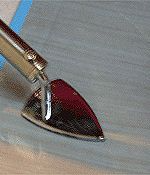
What is a press cloth?
- a piece of muslin, cotton, or similar uncolored fabric
- a sheet of nonstick Teflon press cloth (Kreinik carries these)
- Kreinik also has adhesive press cloths to cover an iron plate
Place your needlework on the ironing surface, cover it with the press cloth, then press with your iron (large home iron or craft size iron). Reposition the cloth as needed to press your project. Do not use steam on the metallic area.
If using fabric as your press cloth, wash it first to remove any sizing, and make sure it is white, not colored. If needed and desired, dampen the fabric slightly instead of using the steam setting on your iron.
The benefit of a nonstick press cloth over fabric: it will last longer and be easier to clean. Also, it's ideal for ironing other items like fusible appliques, interfacing, hem tape, etc as it will keep the adhesive from gumming up your iron.
Side note: should you place your needlework face down on your ironing surface, or face up? Basic cross stitch designs can be ironed face up (with your press cloth on top). If using dimensional stitches like French knots, however, put your needlework face down onto a towel or padded surface, cover with your press cloth (metallics are on the back of your work, too!), and press; this will keep your iron from flattening the stitches.
Get a press cloth and keep it with your cross stitch and embroidery supplies. You will always be ready to finish your beautiful project the safe way, to keep it looking fabulous for years to come. This go-betweener will protect your embroidery and threads—regardless of their content—from potential damage from an iron.
Shop Needlework > Metallic Threads > Braids


